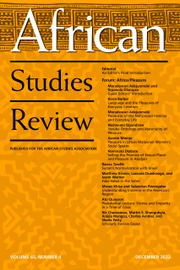Nasong‘o’s book is written with such enviable clarity and intellectual depth that as a reader I found it not just easy to read but also easy to understand. I appreciated its nuanced approach to the complicated history of Kenya and its postcolonial politics. Nasong‘o’s book can be thought of as a story of three colonial periods, the first being the entrance of British colonialists and the havoc they caused; this was quickly followed by American imperialism under the guise of fighting communism and the final period spearheaded by China. These three epochs capture Nasong‘o’s problematization and unfurling of the notion of “post” when speaking about the postcolony. Consequently, Nasong’o captures the atrophying of “the sense of unity and collective purpose.” The result of this is a nation that is less of a nation today than it was six decades ago.
The first era of imperialism, Nasong’o shows, was an era of almosts and paths not taken. It was a period where Kenya could have become a multiracial democracy, but it also could have become an apartheid state in the mold of South Africa. Nasong’o reminds us that owning colonies was a “symbol of great power status … source of national pride,” which explains why “relatively weak and backward countries such as Belgium and Portugal” were keen players in the acquisition of colonies (8). To understand what would happen after colonization with regard to state–society relations, Nasong’o argues that the “coercive and exploitative” nature of colonization would rear its head in the postcolonial period (11). He goes on to add that socioeconomically, colonization led to “perverse development of infrastructure” and a “strengthening of gender bias in national development [through] Victorian rules that … marginalized women in the broader scheme of social and economic matters” among other impacts. He argues that colonialism’s psychological impact was one of “deep-seated ambivalence, characterized by many contradictory feelings and attitude” between colonizer and colonized (13). All of this was present in the way in which postcolonial politics unfolded in these early years where suspicion, deception, and paths not taken in attempts to appease departing colonists and incoming imperialists can be understood as functions of not just the ambivalence wrought by colonization, but a state that understood its place as one meant to coerce citizens and display its power in ways echoing the departing settlers. As Nasong’o is keen to remind us, Kenyatta would come to be referred to as “the black settler” and Kenyatta would come to refer to members of the Kenya Land and Freedom Army (Mau Mau) as a “disease” that had been “eradicated” and needed to be forgotten. Freedom fighters were now “hooligans” not to be allowed to “rule Kenya.”
The second imperial era is one in which the United States played a key role in shaping the trajectory of Kenya. Through characters like William Atwood, Kenya became a vassal of America’s political ambition during the cold war. This is not to say that Kenyan leaders had no agency, but rather that this agency was circumscribed within the boundaries of the cold war needs of the United States. As such, key actors in Kenya’s liberation struggle were marginalized by a president whose freedom they secured. Oginga, Kaggia, and Murumbi were now labeled as “socialist individuals who opened a wedge for the entry of communism into Kenya.”
Authoritarianism was palatable because the United States understood it as necessary for “political stability.” For any observer of Kenyan politics this insistence on “political stability” by the United States foreshadowed another moment where an American political actor—in this case former US Secretary of State John Kerry—called an obviously flawed Kenyan election as “above board” and largely “free and fair.” Nasong’o, therefore, alerts us to the origin of American actors preferring “stability” in much the same way as that of White moderates in Martin Luther King Jr.’s Letter from Birmingham Jail.
The third and final era is the Chinese era which was ushered in by the Kibaki administration. It is a period that Kenya finds itself ensconced in today. Nasong’o argues here that China’s role in countries like Kenya is one that needs to be treated with caution and skepticism while taking the agentic role of countries like Kenya seriously. Nasong’o does a brilliant job of showing the extent to which China has not only entrenched itself in Kenya’s infrastructural survival, but also how it benefits from projects that have no “direct socioeconomic profitability … despite the lucrative loan terms for Chinese financiers, markets for Chinese suppliers, and provision of employment of Chinese labor.” Countries like Kenya act as a waystation for the Chinese government to cycle money out of, and eventually back into, the Chinese economy.
Nasong’o lays asunder the constituent parts that make up the postcolony while asking us to question what and who is state for. While the answer may seem to be easy, Nasong’o book shows that time and time again even well-meaning postcolonial actors find themselves making decisions counter to what we would expect.

